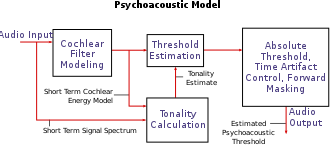Psychoacoustics




Psychoacoustics is the scientific study of the perception of sound. It is a branch of psychophysics and acoustics that explores how humans perceive and process auditory information. This field examines the psychological and physiological responses associated with sound, including how we interpret different frequencies, intensities, and complexities of auditory stimuli.
History[edit]
The field of psychoacoustics has its roots in the work of early researchers such as Hermann von Helmholtz, who studied the sensations of tone and the perception of sound. The development of signal processing and electroacoustics in the 20th century further advanced the study of psychoacoustics.
Key Concepts[edit]
Frequency Perception[edit]
Frequency perception, or pitch perception, is the ability to distinguish different frequencies of sound waves. The human ear can typically hear frequencies ranging from 20 Hz to 20,000 Hz. The perception of pitch is closely related to the frequency of the sound wave, with higher frequencies perceived as higher pitches.
Loudness Perception[edit]
Loudness perception refers to how we perceive the intensity or amplitude of sound. It is a subjective measure that can be influenced by factors such as the frequency of the sound and the duration of exposure. The decibel (dB) scale is commonly used to quantify loudness.
Timbre[edit]
Timbre is the quality of a sound that distinguishes different types of sound production, such as voices or musical instruments. It is determined by the complex waveforms produced by the sound source and is influenced by the harmonic content and the dynamic characteristics of the sound.
Masking[edit]
Auditory masking occurs when the perception of one sound is affected by the presence of another sound. This phenomenon is important in various applications, including audio compression and hearing aids.
Spatial Hearing[edit]
Spatial hearing involves the ability to locate the direction and distance of a sound source. This ability is crucial for navigating environments and is based on cues such as interaural time difference (ITD) and interaural level difference (ILD).
Applications[edit]
Psychoacoustics has numerous applications in fields such as audio engineering, hearing aid design, music production, and noise control. Understanding how humans perceive sound can lead to improvements in sound quality and the development of technologies that enhance auditory experiences.
See Also[edit]
References[edit]
<references group="" responsive="1"></references>
External Links[edit]
Ad. Transform your life with W8MD's Budget GLP-1 injections from $75


W8MD offers a medical weight loss program to lose weight in Philadelphia. Our physician-supervised medical weight loss provides:
- Weight loss injections in NYC (generic and brand names):
- Zepbound / Mounjaro, Wegovy / Ozempic, Saxenda
- Most insurances accepted or discounted self-pay rates. We will obtain insurance prior authorizations if needed.
- Generic GLP1 weight loss injections from $75 for the starting dose.
- Also offer prescription weight loss medications including Phentermine, Qsymia, Diethylpropion, Contrave etc.
NYC weight loss doctor appointmentsNYC weight loss doctor appointments
Start your NYC weight loss journey today at our NYC medical weight loss and Philadelphia medical weight loss clinics.
- Call 718-946-5500 to lose weight in NYC or for medical weight loss in Philadelphia 215-676-2334.
- Tags:NYC medical weight loss, Philadelphia lose weight Zepbound NYC, Budget GLP1 weight loss injections, Wegovy Philadelphia, Wegovy NYC, Philadelphia medical weight loss, Brookly weight loss and Wegovy NYC
|
WikiMD's Wellness Encyclopedia |
| Let Food Be Thy Medicine Medicine Thy Food - Hippocrates |
Medical Disclaimer: WikiMD is not a substitute for professional medical advice. The information on WikiMD is provided as an information resource only, may be incorrect, outdated or misleading, and is not to be used or relied on for any diagnostic or treatment purposes. Please consult your health care provider before making any healthcare decisions or for guidance about a specific medical condition. WikiMD expressly disclaims responsibility, and shall have no liability, for any damages, loss, injury, or liability whatsoever suffered as a result of your reliance on the information contained in this site. By visiting this site you agree to the foregoing terms and conditions, which may from time to time be changed or supplemented by WikiMD. If you do not agree to the foregoing terms and conditions, you should not enter or use this site. See full disclaimer.
Credits:Most images are courtesy of Wikimedia commons, and templates, categories Wikipedia, licensed under CC BY SA or similar.
Translate this page: - East Asian
中文,
日本,
한국어,
South Asian
हिन्दी,
தமிழ்,
తెలుగు,
Urdu,
ಕನ್ನಡ,
Southeast Asian
Indonesian,
Vietnamese,
Thai,
မြန်မာဘာသာ,
বাংলা
European
español,
Deutsch,
français,
Greek,
português do Brasil,
polski,
română,
русский,
Nederlands,
norsk,
svenska,
suomi,
Italian
Middle Eastern & African
عربى,
Turkish,
Persian,
Hebrew,
Afrikaans,
isiZulu,
Kiswahili,
Other
Bulgarian,
Hungarian,
Czech,
Swedish,
മലയാളം,
मराठी,
ਪੰਜਾਬੀ,
ગુજરાતી,
Portuguese,
Ukrainian
